10 Minute Sambal Oelek:
Every South-Eastern Asian family, and restaurant has their own version of sambal oelek. Often multiple versions.
“Sambal Oelek” essentially translates to a chili paste made using the manual grinding method, emphasizing the authenticity and traditional preparation of this fiery condiment
It is a staple in Indonesian and Southeast Asian cuisine, a fiery chili paste that packs a punch of flavor.
Sambal Oelek is just 1 sambal in a much larger family of sambals:
*But when people just say “sambal” – they are usually referring to Sambal Oelek
Common Types of Sambal:
Sambal Oelek: A basic sambal made from ground red chili peppers, salt, and vinegar. It is versatile and widely used.
Sambal Terasi: Includes shrimp paste (terasi) in its ingredients, adding a distinct umami flavor to the spiciness of the chili.
Sambal Belacan: Similar to Sambal Terasi, but it uses belacan (dried shrimp paste) instead of terasi, giving it a slightly different taste.
Sambal Matah: A raw sambal from Bali made with shallots, lemongrass, lime leaves, galangal, and bird’s eye chilies. It offers a fresh and vibrant flavor.
Sambal Kecap: Combines chilies with sweet soy sauce (kecap manis), resulting in a spicy and sweet condiment commonly used for grilled dishes.
Sambal Badjak: Cooked sambal with added ingredients like garlic, shallots, and sometimes tamarind for a richer, savory flavor.
Sambal Goreng: A cooked sambal with additional ingredients like onions, tomatoes, and sometimes meat or seafood, creating a hearty and spicy dish.
Sambal ABC: A popular commercial sambal brand that offers a convenient ready-made option with a balanced flavor.

Sambal Olelek Ingredients:
- 10-12 red chili peppers (adjust for preferred heat level)
- 4 cloves of garlic, (if you LOVE raw garlic, feel free to add more)
- 1 tablespoon rice vinegar, (white vinegar works, but it is a little harsh, start with 2 teaspoons, and taste)
- 1 teaspoon sugar
- 1/2 teaspoon salt to start, (keep adding until it pops, probably won’t need more than 1 full teaspoon)
- Splash of lime juice (optional but good)
Sambal Olelek Instructions:
First, mise en place, and get your workspace clean, gather your tools and ingredients. When making sambal I highly recommend using some kitchen gloves when handling the chilies.

Prepare the Chilies: (Any spicy pepper works, red Thai chilies are the standard)
Wash and deseed the red chili peppers for a milder taste or leave the seeds for an extra kick.
I am using a mix of spicy red peppers and Habaneros.
Chop the chilies and garlic coarsely.

Blend with Garlic:
In a food processor, combine the chopped chilies, garlic cloves, vinegar and lime juice.

Pulse until you achieve a coarse texture. (You might need to add a tablespoon of water to help it become more paste-like)
- Connoisseurs, and every Indonesian I have met, will tell you making it with a mortar and pestle (Molcajete) will result in a better flavor, but it takes some time and elbow grease – up to you
Adjust salt and sugar to taste.
Blend:
Blend all ingredients until you achieve a smooth, paste-like consistency.
Optional Lime Kick:
For a citrusy twist, add a splash of lime juice and stir.
- I always add lime juice, not everyone does

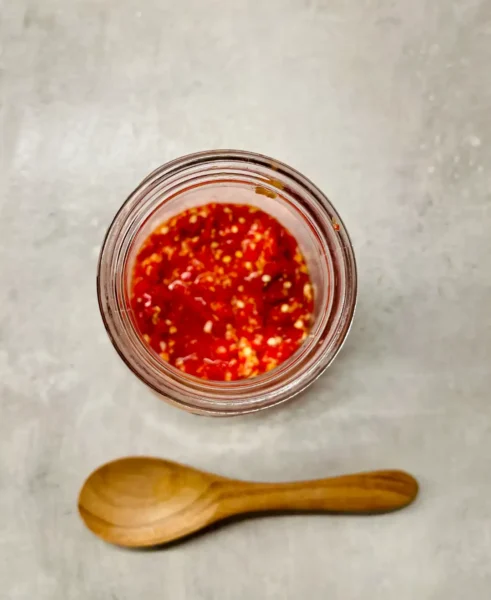
Store or Serve:
Spoon the Sambal Oelek into a clean, airtight jar for storage.
Refrigerate for prolonged freshness.
Why Sambal Olelek works:
- Versatility: Use it as a dipping sauce, marinade, or stir it into soups and stews.
- Intensity: The concentrated chili flavor gives a very bold and spicy kick.
- Homemade: Crafting your Sambal Oelek allows you to customize the heat level and tailor it to your liking.

Sambal Tips and Tricks:
- Experiment with different chili varieties for a unique flavor profile.
- Adjust the sugar and salt ratios according to your taste preferences.
- Let the flavors meld by allowing the Sambal Oelek to sit for a few hours before use.
Spice up your culinary creations with this homemade Sambal Oelek, bringing a burst of heat and flavor to every dish it graces. Enjoy it on meat, vegetables, noodles, and rice.
Sambal Oelek FAQ’s
Question:
What are the best chilies to use for Sambal Oelek?
Answer:
The best chilies to use for making Sambal Oelek are typically red Thai bird’s eye chilies.
These chilies are known for their intense heat and vibrant red color, making them perfect for creating a fiery and visually appealing chili paste.
You can also use red Fresno or red jalapeño chilies if Thai bird’s eye chilies are not readily available. The key is to choose chilies that align with your preferred level of heat, as the type of chili used significantly influences the spiciness of the Sambal Oelek.
Question:
Sriracha vs Sambal. Why do spice lovers prefer Sambal Oelek to Sriracha?
Answer:
For spice enthusiasts, Sambal Oelek reigns supreme over Sriracha due to its unadulterated, intense chili heat. Unlike Sriracha, which combines chilies with garlic, sugar, and vinegar, Sambal Oelek is a pure, undiluted chili paste.
This purity allows Sambal Oelek to deliver an unapologetically fiery kick, unmatched by the more balanced and sweeter notes of Sriracha.
Sambal Oelek lets you revel in the unbridled heat of fresh red chilies, providing a raw and robust spice experience.
It’s the choice for those who crave the unfiltered essence of chili peppers without the sweetness or tanginess that may accompany other hot sauces.
So, if you’re a true spice connoisseur seeking an authentic and intense heat sensation, Sambal Oelek is undoubtedly your fiery ally
Question:
How to Store Sambal Oelek?
Answer:
HOMEMADE Sambal Oelek:
Refrigeration: Preserve homemade Sambal Oelek’s freshness by storing it in an airtight container in the refrigerator. The cold temperature slows down the growth of microorganisms.
Oil Layer: Before sealing the container, ensure the top of the Sambal is covered with a thin layer of oil. This oil layer acts as a natural preservative.
Clean Utensils: Use clean utensils when scooping out the Sambal to prevent contamination.
Storage Duration: Homemade Sambal Oelek is typically good for up to 2-3 weeks in the refrigerator. Regularly check for signs of spoilage.
STORE-BOUGHT Sambal Oelek:
Label Instructions: Adhere to any specific storage instructions provided on the store-bought Sambal Oelek’s label.
Refrigeration: When in doubt, refrigerate store-bought Sambal Oelek to maintain its quality for a longer time.
Clean Utensils: Prevent contamination by using clean utensils when handling store-bought Sambal Oelek.
Check Expiry Date: Keep an eye on the expiry date, and discard the product if it has passed its shelf life.
General Tips:
- Store Sambal Oelek in a cool, dark place away from direct sunlight.
- Avoid introducing moisture by using dry utensils.
- Regularly check for signs of spoilage, such as mold growth, off smells, or changes in color.
Best and Worst Substitutes for Sambal Oelek
Best Substitutes for Sambal Oelek:
Red Chili Paste: Offers a similar fiery kick and is readily available in most grocery stores.
Homemade Chili Paste: Blend fresh red chilies with garlic and a touch of vinegar for a DIY alternative.
Sriracha: Provides a balance of heat and tang, making it a versatile substitute.
Crushed Red Pepper Flakes: Ideal for adding heat to dishes without the paste-like consistency.
Harissa: A North African chili paste with a complex flavor profile, offering depth to dishes.
Worst Substitutes for Sambal Oelek:
Tomato-Based Sauces: Lack the chili-centric flavor and may alter the dish’s intended taste.
Sweet Chili Sauce: Contains added sugars, resulting in a sweet flavor that deviates from the heat of Sambal Oelek.
Barbecue Sauce: Overly sweet and smokey, not suitable for maintaining the authentic chili taste.
Tabasco Sauce: While spicy, the vinegar-forward taste may overpower the intended dish.
Ketchup: Completely different in flavor and texture, making it an unsuitable substitute for Sambal Oelek.
10 Minute Sambal Oelek
Ingredients
- 10-12 Thai bird's eye chilies adjust for preferred heat level
- 4 cloves of garlic (if you LOVE raw garlic, feel free to add more)
- 1 tablespoon rice vinegar (white vinegar works, but it is a little harsh, start with 2 teaspoons)
- 1 teaspoon sugar
- 1/2 teaspoon salt to start (keep adding until it pops, probably won’t need more than 1 full teaspoon)
- Splash of lime juice optional but good
Method
- Prepare the Chilies: (Any spicy pepper works, Thai bird's eye chilies are the standard)
- Wash and deseed the red chili peppers for a milder taste or leave the seeds for an extra kick.
- Chop the chilies coarsely.
- In a food processor, combine the chopped chilies with peeled garlic cloves.
- Pulse until you achieve a coarse texture.
- Add salt, sugar, and rice vinegar to the chili-garlic blend.
- Adjust salt and sugar to taste.
- Blend all ingredients until you achieve a smooth, paste-like consistency.
- For a citrusy twist, add a splash of lime juice and stir.
- I always add lime juice, not everyone does




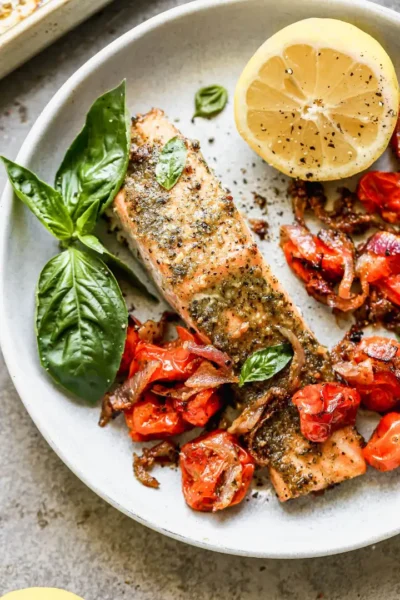



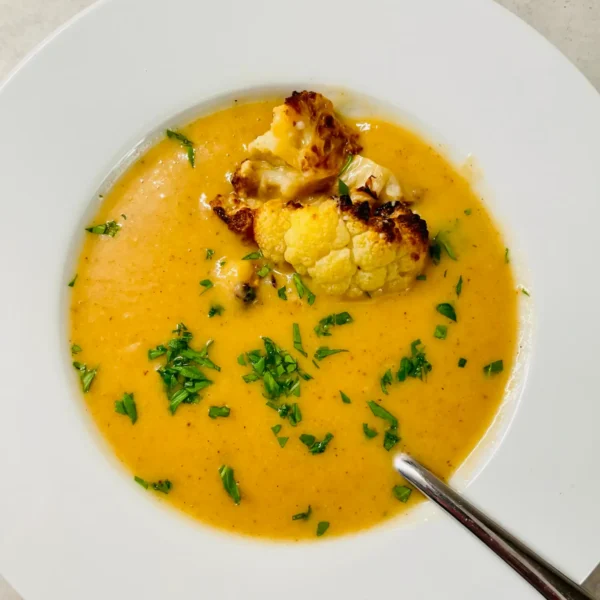



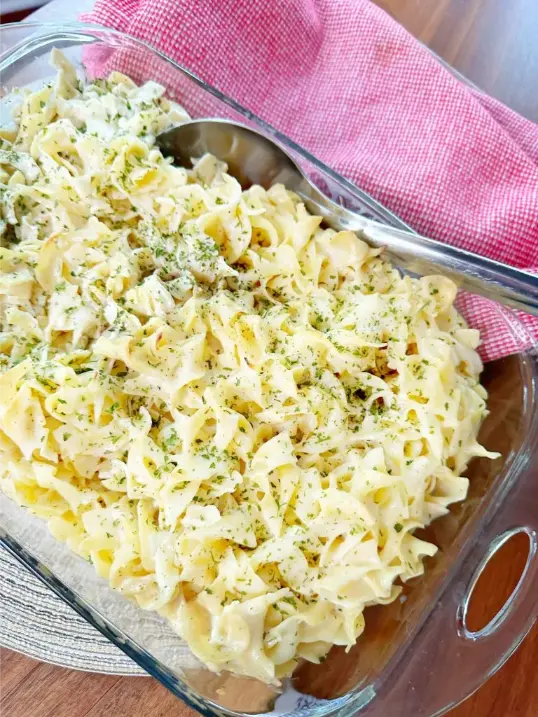


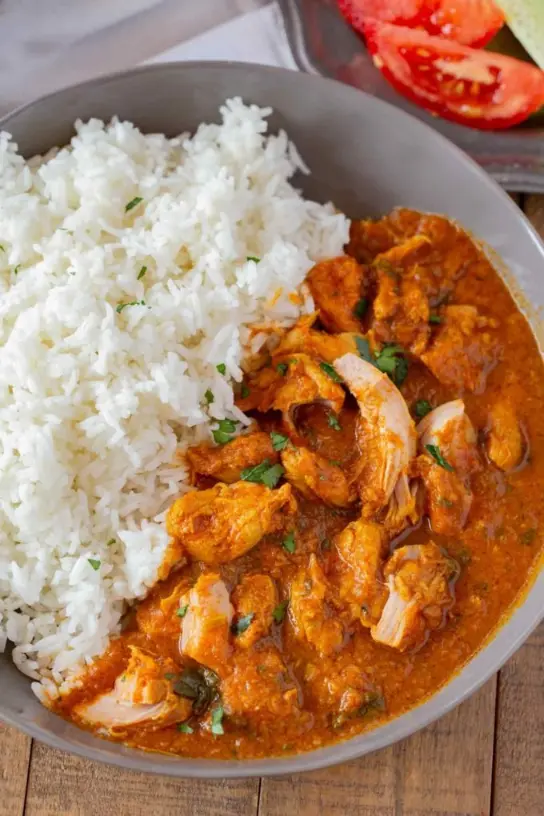







That’s a mean sauce, but good flavor 🔥
Can i use habaneros? I grow them, and i am looking for some recipes. Thanks
Sure, feel free to experiment with whatever peppers you like. Each one has a different taste, and heat level. Habaneros, will have a great heat and flavor.